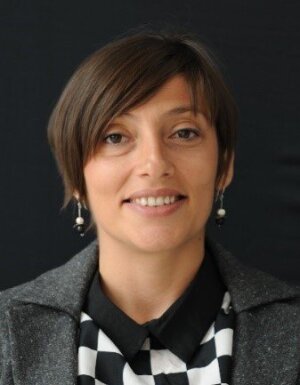
Portrait Dr. Rebeca Marcilla
Foto: Dr. Rebeca MarcillaCurriculum Vitae
Rebeca Marcilla is Senior Researcher of the Unit of Electrochemical Processes of IMDEA Energy. She got the PhD degree in Chemistry at the University of the Basque Country (2006) being awarded with the prize for the best PhD thesis in polymer science in 2005-2006 by the Spanish Polymer Group. Research stay at the Eindhoven University of Technology (Chemical Engineering and Chemistry-Polymer Chemistry) and Postdoctoral stay at the University College London (London Center for Nanotechnology) supported by Marie Curie RTN program and Jose Castillejo program (Spanish Ministry of Science and Education). After her PhD she joined the technological center CIDETEC (Centre for Electrochemical Technologies) acquiring a wide experience in conducting polymers and polymer electrolytes based on ionic liquids. In 2010 she joined to the IMDEA Energy Institute being awarded with a prestigious “Ramón y Cajal” fellowship in 2011. Her main research interest is the development of electrochemical energy storage devices by using new IL-based electrolytes. She is co-author of more than 70 scientific papers in international journals (h 31) and 5 patents. Furthermore, she has been involved in several research projects, including those funded by the European Union, the Spanish Government and by Private Companies. Recently, she was awarded with a prestigious ERC Consolidator Grant to develop an innovative concept of Membrane-Free Redox Flow Battery (MFreeB project, grant agreement No. 726217).
Learn more about Dr. Rebeca MarcillaExterner Link
Abstract
Metal-free and Membrane-Free Redox Flow Batteries by using Immiscible Electrolytes based on organic redox molecules
Rebeca Marcilla
Electrochemical Processes Unit,
IMDEA Energy Institute,
Avda. Ramón de la Sagra 3,
28935 Móstoles, Spain
rebeca.marcilla@imdea.org
Wide-spread implementation of conventional RFBs is limited by some obstacles related to low abundance, toxicity and high cost of vanadium redox compounds, and the poor-performing and expensive ion exchange membranes. Excepting polymer-based RFB (1) where crossover can be mitigated with an inexpensive size-exclusion separator, most RFB require an ion-exchange membrane to prevent the crossover of active species. This key element can account for more than 30 % of the cost of the battery (2) and may limit the long-term battery performance due to unavoidable cross-contamination and insufficient mechanical, chemical and electrochemical stability.
Here, I present an innovative concept of Membrane-Free Battery which proposes to eliminate any separator or membrane by using immiscible redox electrolytes (3). Moreover, the vanadium redox species are replaced by cheap and abundant organic redox molecules that can be specifically designed to exhibit high solubility, adequate redox potentials and suitable partition coefficient between the two immiscible phases. It will be demonstrated that this disruptive technology is hugely versatile with respect to the type of organic redox species as well as the nature of immiscible electrolytes forming the biphasic system. We will discuss the electrochemical performance of Membrane Free batteries based on aqueous/non-aqueous immiscible electrolytes (4) but also a Total Aqueous Membrane-free Battery in which the two phases are aqueous (5), which brings some advantages in terms of cost, environmental issues and battery performance. New challenges such as the inherent selfdischarge in the liquid-liquid interface and future opportunities of this innovative technology will be also discussed.
Grafik zum Abstract
Foto: Dr. Rebeca MarcillaReferences:
- a) Nagarjuna, G.; Hui, J.; Cheng, KJ.; Lichtenstein, T.; Shen, M.; Moore, JS.; Rodríguez-Lopez, J.; J. Am. Chem. Soc. 2014, 136, 16309−16316, b) Janoschka, T.; Martin, N.; Martin, U.; Friebe, C.; Morgenstern, S.; Hiller, H.; Hager, M. D.; Schubert, U. S. Nature 2015, 527 (7576), 78–81.
- Zhang, M.; Moore, M.; Watson, J. S.; Zawodzinski, T. A.; Counce, R. M. J. Electrochem. Soc. 2012, 159 (8), A1183–A1188.
- Navalpotro, P.; Palma, J.; Anderson, M.; Marcilla. Angew. Chem. Int. Ed. 2017, 56, 12460 –12465.
- Navalpotro, P.; Sierra, N.; Trujillo, C.; Montes, I.; Palma, J.; Marcilla, R. ACS Applied Materials&Interfaces, 2018 Article ASAP, DOI: 10.1021/acsami.8b11581
- Navalpotro, P.; Neves, C.; Palma, J.; Freire, M.G.; Coutinho, J.A.P.; Marcilla, R. Advanced Science, 2018, 5, 1800576.
Acknowledgments
MFreeB project has received funding from the European Research Council (ERC) under the European Union’s Horizon 2020 research and innovation programme (grant agreement No. 726217).

